Indole-Containing Natural Products 2019-2022: Isolations, Reappraisals, Syntheses, and Biological Activities
- PMID: 36364413
- PMCID: PMC9655573
- DOI: 10.3390/molecules27217586
Indole-Containing Natural Products 2019-2022: Isolations, Reappraisals, Syntheses, and Biological Activities
Abstract
Indole alkaloids represent a large subset of natural products, with more than 4100 known compounds. The majority of these alkaloids are biologically active, with some exhibiting excellent antitumor, antibacterial, antiviral, antifungal, and antiplasmodial activities. Consequently, the natural products of this class have attracted considerable attention as potential leads for novel therapeutics and are routinely isolated, characterized, and profiled to gauge their biological potential. However, data on indole alkaloids, their various structures, and bioactivities are complex due to their diverse sources, such as plants, fungi, bacteria, sponges, tunicates, and bryozoans; thus, isolation methods produce an incredible trove of information. The situation is exacerbated when synthetic derivatives, as well as their structures, bioactivities, and synthetic schemes, are considered. Thus, to make such data comprehensive and inform researchers about the current field's state, this review summarizes recent reports on novel indole alkaloids. It deals with the isolation and characterization of 250 novel indole alkaloids, a reappraisal of previously reported compounds, and total syntheses of indole alkaloids. In addition, several syntheses and semi-syntheses of indole-containing derivatives and their bioactivities are reported between January 2019 and July 2022.
Keywords: anticancer; antimicrobial; antiviral; cytotoxic; indole; natural products; other bioactivities.
Conflict of interest statement
The authors declare no conflict of interest.
Figures



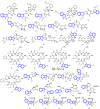

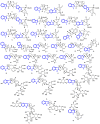


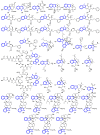

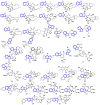
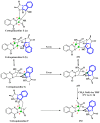







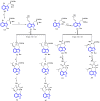







Similar articles
-
3-Acetyl Indole in the Synthesis of Natural Bioactive Compounds.Curr Org Synth. 2025;22(3):328-341. doi: 10.2174/0115701794325027240827043203. Curr Org Synth. 2025. PMID: 40259586 Review.
-
Marine Indole Alkaloids-Isolation, Structure and Bioactivities.Mar Drugs. 2021 Nov 24;19(12):658. doi: 10.3390/md19120658. Mar Drugs. 2021. PMID: 34940657 Free PMC article. Review.
-
Marine-Derived Indole Alkaloids and Their Biological and Pharmacological Activities.Mar Drugs. 2021 Dec 21;20(1):3. doi: 10.3390/md20010003. Mar Drugs. 2021. PMID: 35049859 Free PMC article. Review.
-
Bioactive Alkaloids as Secondary Metabolites from Plant Endophytic Aspergillus Genus.Molecules. 2023 Nov 27;28(23):7789. doi: 10.3390/molecules28237789. Molecules. 2023. PMID: 38067519 Free PMC article. Review.
-
Prenylated indole derivatives from fungi: structure diversity, biological activities, biosynthesis and chemoenzymatic synthesis.Nat Prod Rep. 2010 Jan;27(1):57-78. doi: 10.1039/b909987p. Epub 2009 Nov 19. Nat Prod Rep. 2010. PMID: 20024094 Review.
Cited by
-
Highly regioselective and diastereoselective synthesis of novel pyrazinoindolones via a base-mediated Ugi-N-alkylation sequence.RSC Adv. 2023 Jun 6;13(25):16963-16969. doi: 10.1039/d3ra02065g. eCollection 2023 Jun 5. RSC Adv. 2023. PMID: 37288378 Free PMC article.
-
Construction of multifunctionalized (oxo)indoles via O-Selective interception of the zwitterionic intermediate with N=O.Mol Divers. 2025 Aug 5. doi: 10.1007/s11030-025-11279-3. Online ahead of print. Mol Divers. 2025. PMID: 40762932
-
Tunable C-H functionalization and dearomatization enabled by an organic photocatalyst.Chem Sci. 2024 Feb 6;15(11):4114-4120. doi: 10.1039/d4sc00120f. eCollection 2024 Mar 13. Chem Sci. 2024. PMID: 38487217 Free PMC article.
-
Minor, Nonterpenoid Volatile Compounds Drive the Aroma Differences of Exotic Cannabis.ACS Omega. 2023 Oct 12;8(42):39203-39216. doi: 10.1021/acsomega.3c04496. eCollection 2023 Oct 24. ACS Omega. 2023. PMID: 37901519 Free PMC article.
-
Bisindole Compounds-Synthesis and Medicinal Properties.Antibiotics (Basel). 2024 Dec 13;13(12):1212. doi: 10.3390/antibiotics13121212. Antibiotics (Basel). 2024. PMID: 39766602 Free PMC article. Review.
References
-
- Lahlou M. The success of natural products in drug discovery. Pharmacol. Pharm. 2013;4:17–31. doi: 10.4236/pp.2013.43A003. - DOI
-
- John J.E. Natural products-based drug discovery: Some bottlenecks and considerations. Curr. Sci. 2009;96:753–754.
-
- Appendino G., Fontana G., Pollastro F. Natural Products Drug Discovery. In: Liu H.-W., Mander L., editors. Comprehensive Natural Products II. Elsevier; Oxford, UK: 2010. pp. 205–236.
Publication types
MeSH terms
Substances
Grants and funding
LinkOut - more resources
Full Text Sources

